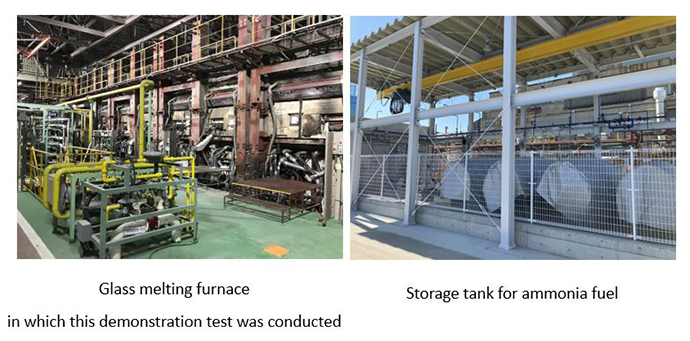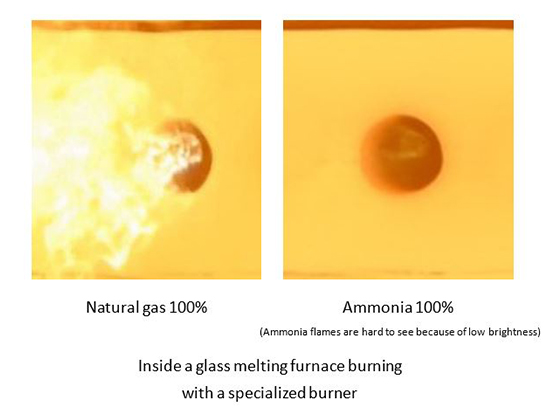|

September 19, 2023
By Julian Atchison
Ammonia fuel for glass production
demonstrated in Japan
Asahi Glass Corporation
Earlier this June, AGC announced it had
successfully used 100% ammonia fuel to produce architectural glass
over two days of testing at its Yokohama Technical Center. The project
is an ongoing joint effort, with technical contributions from Taiyo
Nippon Sanso Corporation, the National Institute of Advanced
Industrial Science and Technology & Tohoku University, and support
from government body the New Energy and Industrial Technology
Development Organization (NEDO). AGC confirmed that effects on glass
quality and furnace materials, control of flame temperature, furnace
temperature, and nitrogen oxide (NOx) emissions were all within
acceptable limits.

Glass melting furnace & ammonia fuel storage in
Yokohama, where the ammonia fuel demonstration tests took place.
Source: Asahi Glass Corporation.

100% gas flame (left) compared to a 100% ammonia flame
(right) inside a glass melting furnace. Source: Asahi Glass
Corporation.
An ammonia-oxygen burner was developed by Taiyo
Nippon Sanso, and designed to “prevent a rapid rise in flame
temperature through multi-stage combustion”. Compared with
conventional fuel combustion (and with tests run under various
conditions), the NOx concentration in the exhaust gas was found to be
below environmental thresholds, while maintaining the required
temperature of the glass melting furnace. From next year, the partners
plan to conduct scaled-up tests and demonstrate the technology at
other AGC sites. From 2026, AGC’s goal is to fully introduce ammonia
combustion technology across its operations. The technology could also
be applied to manufacturing other materials such as steel or aluminium.
…and cement!
The news follows an announcement from Mitsubishi UBE Cement
Corporation in April. MUCC revealed it had begun ammonia co-combustion
tests to produce cement clinker at its Ube Cement Plant (clinker is an
intermediary product leading to Portland cement). To this point, coal
has been the primary fuel in this process, with about one tonne of
carbon dioxide emitted for every tonne of limestone processed. MUCC
reports successful tests, with a goal to increase co-combustion in
stages up to 30%. MUCC predecessor Ube Industries participated in the
Japanese government’s Strategic Innovation Promotion Program (SIP)
from 2014 to 2018.
Green Play Ammonia™, Yielder® NFuel Energy.
Spokane, Washington. 99212
509 995 1879
Cell, Pacific Time Zone.
General office:
509-254
6854
4501 East Trent
Ave.
Spokane, WA 99212
|